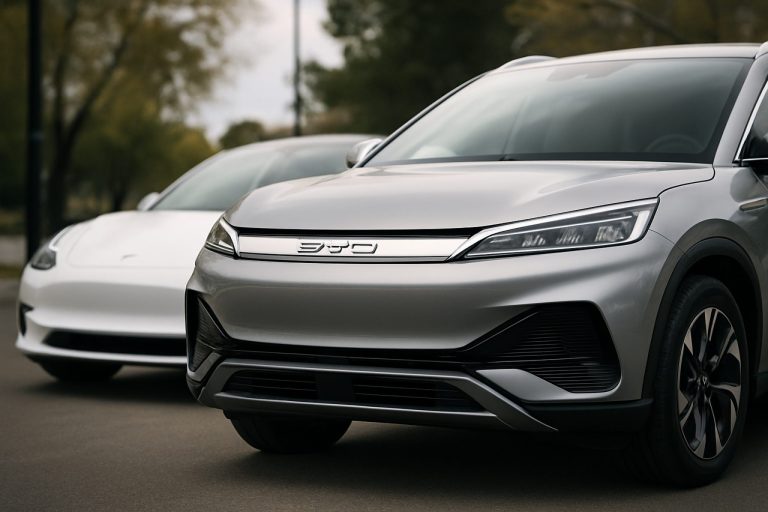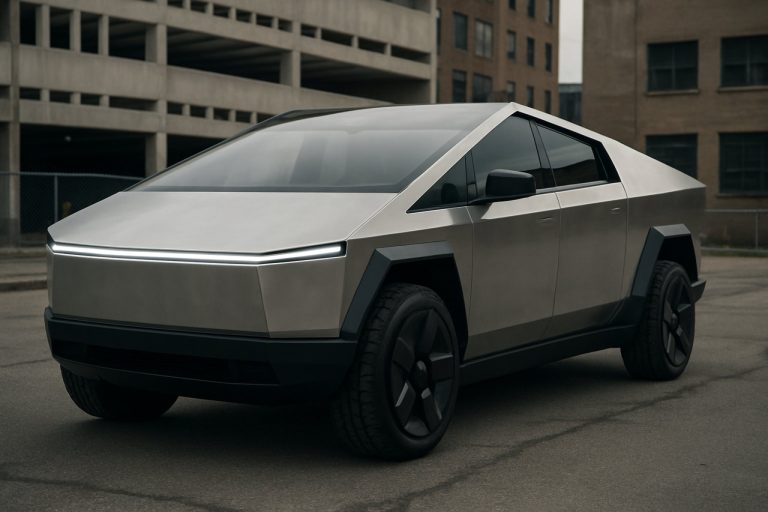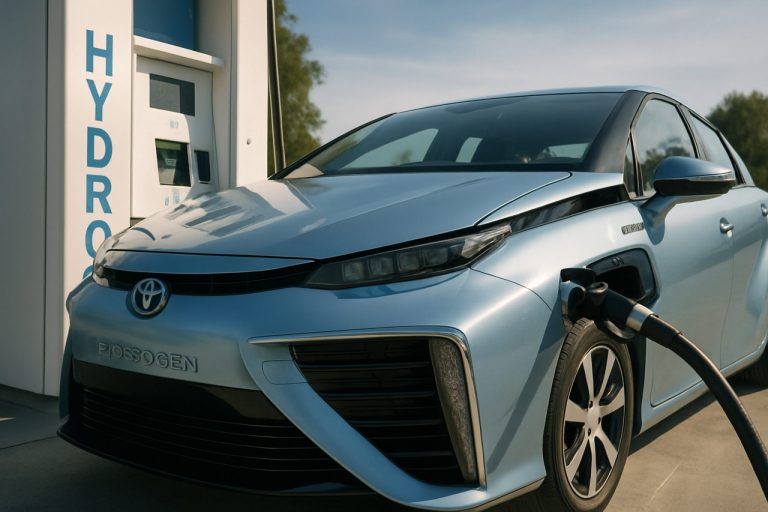
- Hydrogen cars promised clean, zero-emission travel but remain rare in America due to technical, economic, and infrastructure challenges.
- High costs for hydrogen stations, complex storage needs, and limited availability have slowed adoption of hydrogen vehicles.
- Most hydrogen is still made from natural gas (“gray hydrogen”), which emits carbon; “green hydrogen” is cleaner but expensive and scarce.
- Battery electric vehicles (BEVs) have surged ahead thanks to better technology, a rapidly growing charging network, and strong market momentum.
- Hydrogen cars are less energy efficient than BEVs, with greater losses from production to propulsion.
- Today, hydrogen’s future is more promising in heavy industry, shipping, and trucking than in passenger cars.
A generation has grown up since a U.S. president pledged that the cars of tomorrow would run on the universe’s lightest element. Yet America’s driveways are still ruled by gasoline and, increasingly, black-and-silver EVs charged by wall plugs—not hydrogen pumps.
The vision shimmered with promise: vehicles gliding down highways exhaling only water vapor, not a molecule of smog. Hydrogen, abundant and clean-burning, beckoned as an escape hatch from fossil fuel dependency and spiraling emissions. Automakers like Toyota and Honda poured research dollars into prototypes. Scientists raced to solve the technical puzzles. The White House promised billions.
But the hydrogen car—once cast as the leading star of zero-emission travel—has yet to claim a meaningful role on the American stage.
Why didn’t your neighbor, or you yourself, ever end up with a hydrogen-powered sedan in the driveway?
Walk into any California city—where hydrogen stations dot a few select zip codes—and you’ll quickly see the challenges that have dogged this technology. Light as a feather, hydrogen demands high-pressure storage and robust safety protocols. The refueling stations themselves cost millions to build and maintain. Today, fewer than 60 public stations operate in the entire U.S., most of them clustered on the West Coast.
Hydrogen’s biggest Achilles’ heel, though, hides in plain sight: how it’s made. Nearly all of the world’s hydrogen supply comes from splitting natural gas—a process that pumps vast amounts of carbon dioxide into the atmosphere. Scientists call this “gray hydrogen.” True “green hydrogen”—produced by splitting water using wind or solar electricity—remains scarce and expensive. Costly electrolysis technologies and patchy clean energy grids still mean that green hydrogen costs at least twice as much as its fossil-fuel cousin.
Meanwhile, battery electric vehicles (BEVs) stole the show, propelled by rapid leaps in battery tech and a blossoming public charging network. Tesla, once a Silicon Valley curiosity, is now a juggernaut. Ford, Chevrolet, Volkswagen—the lineup of electric models expands every year. Americans plug into charging points at grocery stores and along interstate highways, not at high-pressure hydrogen pumps.
Federal policies have played hopscotch, veering from hydrogen-blessed to EV-focused and back, ultimately providing little continuity for hydrogen’s consumer ambitions. Today, the U.S. government still invests in hydrogen technology—but mostly for its potential in heavy industry and long-haul trucking, not the family SUV.
Crucially, the math never quite worked for hydrogen cars: Turning electricity into hydrogen, moving and storing it, then converting it back in a fuel cell wastes much of the original energy—roughly triple the losses compared to simply charging a battery. For most passenger vehicles, the numbers tip decisively in favor of batteries.
Still, hydrogen hasn’t faded into obscurity. Far from it. The world’s largest automakers, global ports, and manufacturers see opportunities in trains, cargo ships, and steel mills—places where batteries are too heavy or slow to recharge, and where emissions cuts are desperately needed. The International Energy Agency places hydrogen at the heart of decarbonizing heavy transport and industry as the world moves toward net-zero goals.
The key takeaway is simple: Hydrogen failed to become the car fuel of a new American century—not for lack of vision, but for hard technological, economic, and political realities. Yet this same element remains critical in the harder-to-reach corners of the green revolution.
Dreams of a pollution-free hydrogen sedan remain possible—but only if breakthroughs bring costs down, refueling stations multiply, and climate ambition translates into sustained policy action. For now, the road to a cleaner future curves in a new direction: batteries for most cars, hydrogen for the toughest jobs. The hydrogen car moment, it turns out, arrived ahead of its time.
Why Hydrogen Cars Haven’t Conquered American Roads—And Where the Real Hydrogen Revolution Is Happening
Hydrogen Cars: History, Promise, and the Tough Road Ahead
For decades, hydrogen-powered cars were billed as the future of “clean driving.” Despite high hopes, hydrogen vehicles never took over American driveways, while battery electric vehicles (BEVs) like those from Tesla, Ford, and Volkswagen have surged ahead. To understand the realities—and what’s next—let’s dive deep into hydrogen’s journey, industry use cases, environmental impact, and the factors shaping its market prospects.
—
Key Facts Ignored or Underexplored In the Source Article
1. How Hydrogen Cars Actually Work
– Hydrogen fuel cell vehicles (FCEVs) use a fuel cell stack to convert compressed hydrogen into electricity, emitting only water vapor as exhaust.
– The driving range of major FCEVs like the Toyota Mirai and Honda Clarity typically exceeds 300 miles per fill-up—comparable to many BEVs.
– FCEVs can refuel in 3–5 minutes, far quicker than most BEV charging cycles, which can take 30 minutes (fast-charging) to several hours.
2. Industry Adoption: Beyond Passenger Cars
– Sectors like heavy trucking, railways, global shipping, and aviation are actively piloting hydrogen solutions for long-haul transport, where battery weight, charging times, and energy density remain problematic ([International Energy Agency](https://www.iea.org)).
– Steel, fertilizer production, and chemical manufacturing see green hydrogen as a crucial decarbonization tool.
3. Environmental Impact: Not All Hydrogen Is Equal
– “Gray hydrogen” (from natural gas) currently makes up ~95% of global production, emitting about 10 kg of CO₂ per kilogram produced ([U.S. Department of Energy](https://www.energy.gov/)).
– “Blue hydrogen” captures some emissions through carbon capture technologies but still has leakage and sequestration risks.
– Only “green hydrogen” (via renewable-powered electrolysis) is emission-free, but it remains cost-prohibitive at $4–$6/kg vs. $1–$2/kg for gray hydrogen.
4. Infrastructure—The Bottleneck
– The U.S. falls far behind Europe and Asia in hydrogen station count. Japan boasts over 160 stations; the EU aims for “hydrogen corridors.”
– Building a single high-pressure hydrogen refueling station can exceed $2 million in upfront cost.
—
Real-World Use Cases: Where Hydrogen Shines
– Long-Haul Trucking: Nikola Motor and Hyundai are deploying hydrogen semis for distances where batteries fall short due to weight and range constraints.
– Public Transportation: Cities in Germany, China, and California have hydrogen-fueled buses for emission-free mass transit.
– Decarbonizing Industry: Companies like ArcelorMittal are trialing hydrogen for zero-carbon steelmaking.
—
Market Forecasts & Industry Trends
– The global hydrogen market is projected to grow from $160B in 2022 to over $260B by 2027, led by industrial and heavy-duty transport sectors ([BloombergNEF](https://about.bnef.com/)).
– Major automakers (Toyota, Hyundai, BMW) continue to invest in FCEV development, but with a stronger pivot toward commercial, fleet, and specialty markets.
—
Reviews & Comparisons: Hydrogen vs. EVs
| Feature | Hydrogen FCEVs | BEVs |
|———————|——————–|———————–|
| Refueling Time | 3–5 minutes | 30–60 minutes (fast) |
| Range | 300–400 miles | 200–400+ miles |
| Cost per Fill/Charge| $60–$100 | $10–$20 (home charge) |
| Infrastructure | Limited (US: ~60) | Expanding (US: 55,000+)|
| Emissions | Water vapor (+ CO₂ if gray H₂) | None if charged with renewables |
BEVs are currently cheaper to own and operate, with stronger infrastructure and government incentives.
—
Controversies, Limitations & Security
– Hydrogen is highly flammable, requiring robust storage/handling (700 bar pressure tanks).
– Critics argue that pushing gray or blue hydrogen maintains fossil fuel dependence.
– “Hydrogen Superpower” nations (e.g., Australia, Saudi Arabia) are eyeing exports of green hydrogen, spurring geopolitical competition.
– For the average American commuter, EVs are more practical and affordable—until production of green hydrogen and reliable, affordable refueling grow.
—
Insights & Predictions
– Expect BEVs to remain dominant in private transport through 2035.
– Hydrogen’s biggest breakthroughs are likely in decarbonizing flights, ships, and industrial giants—applications where batteries can’t yet compete.
– Policy, not just technology, will determine if and where hydrogen achieves mass adoption.
—
Pros & Cons Overview
Pros:
– Zero-emission tailpipe (water vapor only)
– Quick refueling and long driving range
– Storage potential for excess renewable energy
Cons:
– High cost of green hydrogen production
– Scarce refueling infrastructure
– Energy inefficiency vs. batteries
– Ongoing reliance on fossil fuels for most current production
—
Pressing Questions Answered
Will Hydrogen Cars Ever Be Common in the U.S.?
Unlikely in the near term, unless infrastructure sees an unprecedented expansion and costs fall dramatically. BEVs will outpace FCEVs for private cars.
Is Green Hydrogen Becoming Cheaper?
Gradually, as electrolyzer costs fall and renewable energy grows, but full parity is years away ([IEA](https://www.iea.org)).
Can Hydrogen Help Solve the Renewable Energy Storage Problem?
Potentially. As a long-term, seasonal storage medium, hydrogen could stabilize grids reliant on wind and solar.
—
Actionable Recommendations & Quick Tips
– For eco-conscious drivers: If emissions are your main concern, a BEV powered by renewable electricity is a better choice today.
– For investors/businesses: Watch for hydrogen’s impact in long-haul transport, shipping, and heavy industry, not consumer vehicles.
– For policymakers: Accelerate green hydrogen production and expand infrastructure only where batteries cannot compete.
– For STEM students/enthusiasts: Consider careers in electrolyzer R&D, fuel cell engineering, or hydrogen logistics—these will be growth fields.
—
For more on global energy trends and hydrogen’s evolving role, see the [International Energy Agency](https://www.iea.org).
—
In Summary:
Hydrogen cars aren’t dead—but battery EVs have already won the “mainstream family car” race. Hydrogen’s true potential lies in powering the heavy, hard-to-electrify backbone of industry and transport as the world pushes toward net zero. Watch this space—hydrogen’s big moment might still be just ahead, even if it’s not in your driveway.



